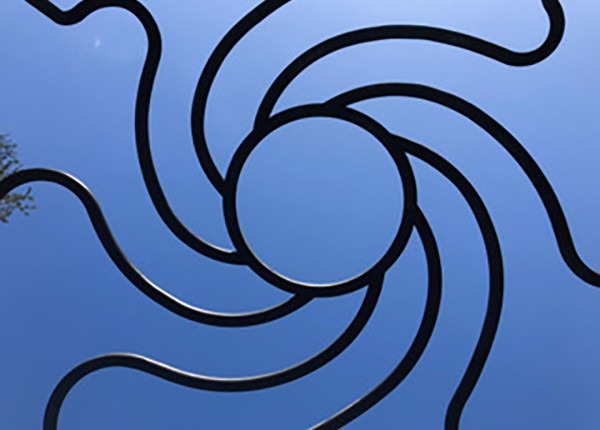As this year swings toward a new start, we asked a range of artists and arts supporters for a special detail they’ve noticed in a work of art, something that makes this work special for them.
We received such lovely answers, all so different. Here’s a year-end gift of special moments people noticed.
For me, I often think that I’m the only one who’s noticed that when Fred and Ginger dance “Isn’t It A Lovely Day (To Be Caught in the Rain)” in Top Hat – it’s a dance where they’re completely equal. She is wearing pants and loafers and they’re mostly side by side. She even imitates Fred, as they give the lovely illusion that they’re figuring it out together.
Unlike other dances where Fred swoops her up and he is leading, Ginger stands her ground here. He spins her and she spins him, he swings her and she swings him back – for me the only false note is a fleeting moment where she’s waiting to be scooped up briefly in his arms.
. . .
It’s different, almost casual, they’re true partners – and they shake hands when it’s over.
. . .
If you’d like to share something special that you see in a work of art,
you can email s.cowley@creativepinellas.org,
and we’ll be updating this feature.
Jody Bikoff
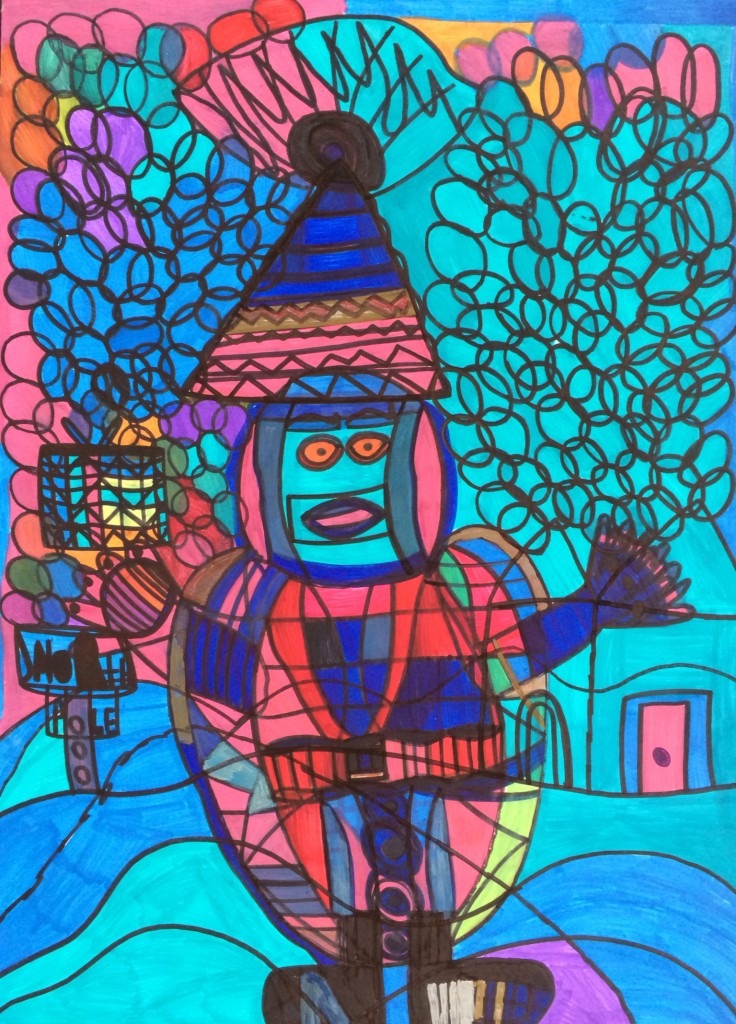
“The Skater, a sharpie drawing by Joseph “JJ” H., has won my heart this holiday season. It reminds me of past winters in New York City when my children were young. We would go ice skating at Wollman Rink in Central Park, travelling from our home, downtown in Greenwich Village. My youngest daughter was a bundle of winter clothes – puffy jacket, hat and gloves and ice skates.
“As I look at this drawing I feel the snow and ice around us, the rink aglow in wintery light. We often went late afternoon through early evening, taking breaks for hot chocolate, in a building behind the glistening rink.
“I love when art ignites my memories and senses.”
. . .
. . .
Harriet Monzon-Aguirre
. . .
I have always loved Tampa Airport for its design and functionality. For me this airport holds a special place in my heart because it evokes fond memories of being embraced by loved ones during semester breaks.
Similar to the opening scenes from Love Actually, I can vividly recall the anticipation of stepping off the plane, and then the shuttle to be greeted by warm hugs and smiles. You’ve arrived safe and sound for the holidays.
. . .
Fast forward to today and even though Tampa Airport has expanded as a hub for millions of visitors every year, this liminal space still evokes those memories. I recently visited the airport to pick up my husband and I came across a beautiful floor-to-ceiling sculpture called HOME by Matthew Mazzotta.
A massive flamingo, the sculpture is hand-sculpted resin and fiberglass. Look down to the floor and you notice three rings of metal beads meant to act as a gentle reminder to stay off the flamingos’ feet and beak. As nice as the reminder was, these beads could not stop a little boy from embodying the spirit of the season and giving the flamingo a warm embrace.

Another part of the art I admired was how the artist created the illusion of being underwater. Look up to the ceiling and there is a wavy reflective surface with spinning spotlights creating movement. The size and perspective made me feel like we the viewers were shrimp compared to the bird.
I just love flamingos with their long legs and curvy necks. Did you know that American flamingos are native to Florida? At the turn of the 20th century they disappeared from the State. They are a protected species, and slowly their numbers are growing.
I researched a bit more about HOME. In the Tampa Airport News, Airport CEO Joe Lopano says, “We are more than a place that people simply pass through – we are the first and last impression of the Tampa Bay region. . . Public art is critical to creating a sense of place and leaving our guests with a unique and engaging experience.”

In the same article, Executive Vice President of Marketing Chris Minner, who also sits on the Public Art Committee, says public art makes these spaces distinctive and memorable.
“Every airport has terminals, seating, gates and travelers – and every airport functions as a gateway,” said Minner. “But how this initial experience happens – how it feels during those welcomes and goodbyes – is what elevates our shared experience and invites our travelers to become true representatives of our region.”
For me personally, the Tampa Airport will always be memorable, yet the installation of this beautiful flamingo is impactful for others and it is extremely encouraging and exciting as an artist to see this Tampa Bay area acknowledge and embrace the power of public art.
. . .
Robin Miller

. . .
The Dolphin Trail Art on each Dolphin across the county.
. . .
. . .
Roxanne Fay
. . .
My favorite small gems are the nods made by an artist to another artist. Prolific songwriter Warren Zevon had myriad such small homages in his work, often citing his friends Elmore Leonard and Carl Hiaasen.
On Zevon’s final album, The Wind, released shortly before his death from mesothelioma, the song “My Ride’s Here” contains this nod to Leonard. . .
. . .
I was staying at the Marriot with Jesus and John Wayne
I was waiting for a chariot, they were waiting for a train
And the sky was full of carrion
“I’ll take the mazuma”, said Jesus to Marion-
“That’s the 3:10 to Yuma.”
. . .
“3:10 To Yuma” being a short story by Elmore Leonard.
Hiaasen often cites Zevon and/or dedicates works to his friend, Zevon.
Zevon’s song “Basket Case” was written for Carl Hiaasen for his book of the same name. Hiaasen had written the first line or two and asked Zevon to kind of jot off a quick set of lyrics.
Zevon, instead, composed a complete song and surprised Hiaasen with it.
. . .
“My baby is a basket case
A bipolar mama in leather and lace
Face like an angel, she’s a perfect waste
My baby is a basket case”
Shane Hoffman
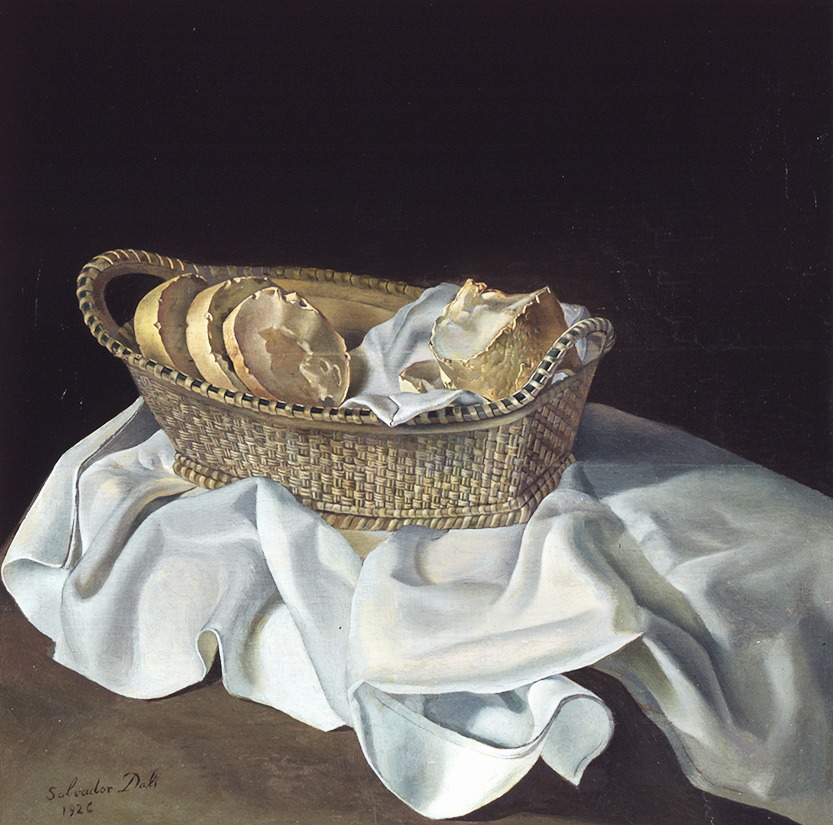
. . .
I have always looked at Salvador Daíi’s The Basket of Bread as an achievement in executing sharpness and weight with a brush.
Instead of light fluffy bread, or even stale bread, it seems to me that Dalí is depicting broken bread as a painted marble sculpture.
It’s so heavy, airless and sharp. It’s the first painting I look for when I go to the museum. It makes me want to paint whenever I see it.
. . .
. . .
David Warner
When you’re sitting in the nosebleed seats in a Broadway theater and you know exactly what thoughts are going through a character’s head — that’s how it was when my husband and I saw Cherry Jones in ’The Heiress” by Ruth and Augustus Goetz – from way up in the second balcony of the Cort (now the James Earl Jones) Theatre in 1995.
It was the crucial moment at the end of the play when, as Catherine Sloper (the heiress of the title), Jones turned and headed up the staircase, leaving her would-be suitor to call for her in vain outside the door.
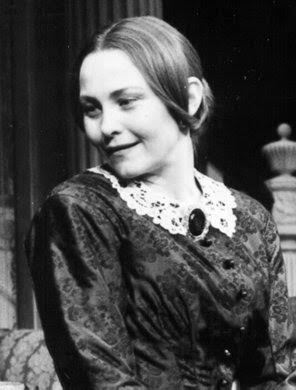
As a writer for Backstage later described it, her performance at that moment conveyed “a final amalgamation of inner pride and triumph, mixed with the heavy resignation of loneliness and the burden of financial fortune.” Because of the way she turned her head and moved up the stairs, because of the resolve and pain evident on her face, we all saw that, too.
For me, it was an indelible reminder of the actor’s alchemy – that if you’re fully inhabiting your character you can reach the audience even if they’re way up in the nosebleed seats.
. . .
. . .
Tony Palms

. . .
There’s a public art program, currently comprising 35 art works across the three campuses of the University of South Florida. At one point this collection ranked in the top ten of university public art programs in the nation.
One of the works is Solar Rotary by Nancy Holt, the land art artist who has created celestial installations around the globe.
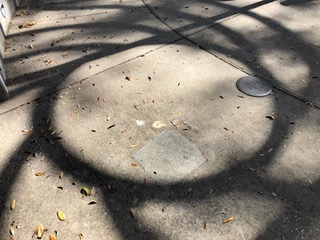
Completed in 1995 and located in the plaza next to the Communication and Information Sciences Building on the main Tampa campus, Solar Rotary is a ring with long curving radial lines that spread out and bend to the ground, holding the the Sun-like ring structure aloft about 20 feet into the air.
Directly below the ring is a circular seat with a 4.5 billion year old meteorite embedded in the center.
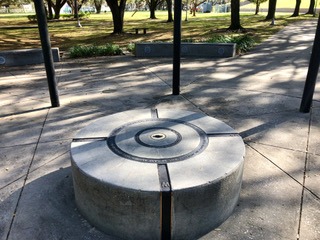
On sunny days, the ring casts a shadow, and as the sun moves across the sky, so does the ring shadow move across the plaza.
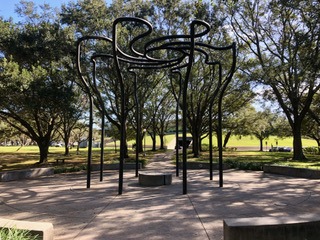
At solar noon on summer solstice, the ring shadow perfectly surrounds the meteorite seat. Every year, people gather to witness this moving cosmic phenomenon.
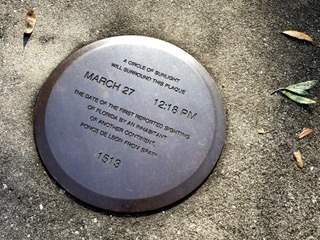
And on five other notable days, the ring shadow encircles specific plaques imbedded in the ground around the plaza, each one commemorating a historic event in the state of Florida – like establishing the town government for the city of Tampa on January 25, 1849, or the first sighting of Florida by Ponce de León on March 27, 1513.

That ring mediates, as a telescopic portal for Earthlings looking up pondering the endless sky – and as a microscopic keyhole for the Sun observing from its abode, the minutia of every day on planet Earth.
More details from the USF Contemporary Art Museum link –
usfcam.usf.edu/PA/Pages/pa_holt
 . . .
. . .
Margo Hammond
. . .
Life is bearable after all
. . .
On Earth Day in 2015 one of my childhood friends died. Tom was living in St. Petersburg because I had introduced him to Karen, a friend of mine here, and they had fallen in love. He had asked me to be his best “man” at their wedding. For years I thought that pairing up Tom and Karen was the greatest accomplishment of my life. I had never seen two people so happy together.
One afternoon I stopped by to see Tom because he had called and said that he had something important to tell me. Karen was at work. He was in the kitchen, as usual, making us cappuccinos with his impressive machine. When I walked in, he dropped the bombshell – he had esophageal cancer. He didn’t have long to live.
He asked me not to tell Karen that there was no chance of recovery. He was a science writer. He was prepared for what was to come. She needed to keep hoping for a miracle. I promised him I would stay by her side with all the support I could muster.
That night I went to see my friend, a cellist in the Tampa Bay Symphony, play Tchaikovsky’s 6th. I cried through the whole performance.
Tchaikovsky called his 6th Symphony the Passion Symphony, but it was mistranslated into French as Pathétique and is now known by that moniker which means evoking pity.
. . .
There has always been a great deal of speculation about this symphony, Tchaikovsky’s last. The Russian composer died nine days after he conducted its premiere in St. Petersburg (the other St. Petersburg, of course) in 1893.
Some have speculated that the symphony was a suicide note, that he committed suicide because the truth of his sexual orientation was about to be made public, that Tchaikovsky had written his own requiem. Others say that is nonsense. He had contracted cholera and couldn’t possibility have known he was about to die when he was writing the work.
We do know that he had tried to commit suicide in the past after his marriage spectacularly fell apart. We do know that he was gay. But there is evidence that he was comfortable with his sexuality (his orientation was an open secret among those close to him) and that 19th century Russia was not as intolerant of homosexuality as present-day Russia is.
We’ll never know what Tchaikovsky really was thinking when he composed his last symphony but I do know that night when I was listening to the Tampa Bay Symphony play it, his music transcended biography. His notes rattled my heart.
. . .
I had many months to say goodbye to Tom. We had several more dinners together, many more days of laughter and I was able, repeatedly, to tell him how much he had meant to me in my life, how much I was going to miss him.
That was a conversation I was never able to have with Karen. She unexpectedly died just under six years later. In early 2021. From a fall perhaps. We don’t know. When she didn’t answer our calls, friends went to check up on her. They found her unconscious in her bed. She never woke up. We had braved that first year of the pandemic together, only to have one of us die of something that had nothing to do with COVID.
I had kept my promise though. I had stood by her as best as I could. We marked every Earth Day with a dinner al fresco on Beach Drive. We audited classes at USFSP. We went to restaurants. She cooked for me. I brought her wine. A mutual friend who played violin with the Florida Orchestra got us tickets to dozens of concerts.
She had never been to a symphony orchestra. What should I wear, she asked, the first time we went. Anything goes, but shorts, I told her. At every concert after that, she delighted in pointing out to me someone who had come in shorts. She always insisted on sitting up as high as we could so we could see the entire orchestra. She called the first violinist her “boyfriend.” She had never seen a musician so animated.
Tchaikovsky was often on the program. His 6th, of course, will always remind me of Tom – and you might imagine that now the Pathétique, linked to the composer’s sudden and mysterious death, would also make me think of Karen.
. . .
But it is Tchaikovsky’s 4th that I associate most with her. Tchaikovsky wrote it after that failed suicide attempt when he was trying to be happy once again. Its bittersweetness and triumphant finale always addresses perfectly the time we had together, trying to cope with sadness.
“Life has you tired out. Many things flit through the memory… there were happy moments when young blood pulsed warm and life was gratifying. There were also moments of grief and of irreparable loss. It is all-remote in the past. It is both sad and somehow sweet to lose oneself in the past. And yet, we are weary of existence,” Tchaikovsky wrote, describing the second movement of his 4th Symphony.
And then, commenting on his last movement, he wrote, “If you cannot discover the reasons for happiness in yourself, look at others. Upbraid yourself and do not say that the entire world is sad…
“Take happiness from the joys of others. Life is bearable after all.”
. . .
creativelatebloomers.blogspot.com
. . .
Laura Castro
“Fireflies” was the lead single of the album Ocean Eyes by Owl City. I had discovered Owl City the year prior to the song’s meteoric rise to number one on the Billboard Hot 100 in 2009.
I remember being so proud seeing the music video being played on Tyrone Mall’s video screens at the food court. It is a wonderful thing to see something you love being recognized for its greatness.
The first few notes of the song still elicit pangs of sweet melancholy even now. The music video pairs perfectly with the song and adds additional layers of whimsy.
The video begins with Adam Young, the person behind Owl City, alone at his piano. A detail that I love is that the piano has a “magic” button, seen only for a second at the beginning. Once he begins playing the piano, all sorts of toys become animated and the whole room buzzes with activity.
To me, this captures the artist experience – feeling truly alive when being creative. The ending of the video further enhances this point. It ends in a lethargic scene with all action ceasing as the piano stops being played.
I highly recommend giving the “Fireflies” music video a watch and the album Ocean Eyes a listen for a beautifully dreamy synth-pop experience.
. . .
. . .
Bob Barancik

A good friend just pointed out to me that there is a six-sided Jewish Star Of David on the back of every US $1 bill.
I checked out the backstory online – “The History of the $1 Bill and Who Was Haym Solomon.”
. .
. . .
Paula Kramer

“We were walking through an exhibit of Franz Kline’s striking black and white abstract paintings at MOMA years ago, and across the room I caught a glimpse of one that looked familiar. I told Tom, ‘That looks like Merce Cunningham,’ such an amazing dancer and choreographer, I know his work so well.
“And when we got closer, it was.”
. . .
creativepinellas.org/magazine/arts-in-tom-and-paula-kramer
. . .
Here’s to a creative 2023
. . .
